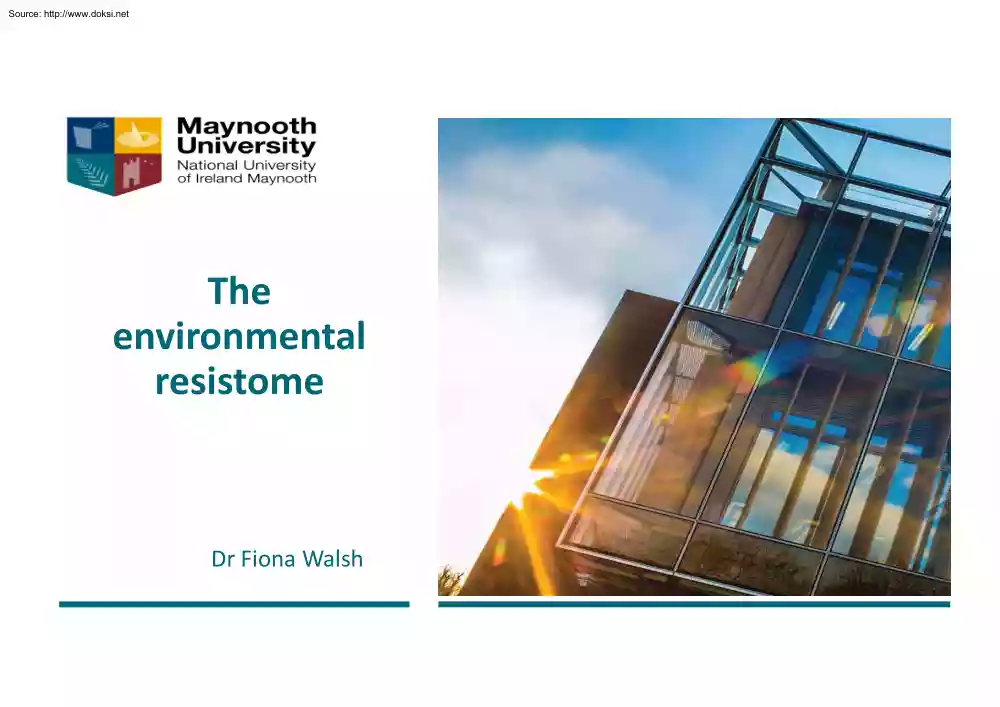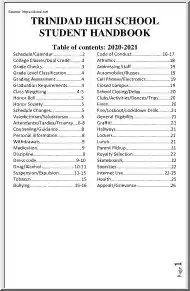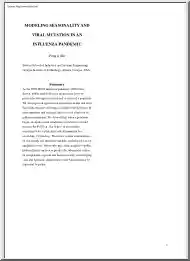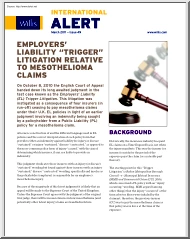A doksi online olvasásához kérlek jelentkezz be!

A doksi online olvasásához kérlek jelentkezz be!
Nincs még értékelés. Legyél Te az első!
Mit olvastak a többiek, ha ezzel végeztek?
Tartalmi kivonat
Source: http://www.doksinet The environmental resistome Dr Fiona Walsh Source: http://www.doksinet Where does AR originate? Recent years Billions of years ago Bacteria emerge from premordial soup Bacteria live in the environment together producing and resisting antibiotics, bioactive compounds and toxins Antibiotics in medicine Antibiotic resistance research Dr Fiona Walsh/Biology Department Source: http://www.doksinet Concepts to date relating to environment Soil = Reservoir of antibiotic resistance Manure increases the abundance and diversity of resistance genes Faecal pollution of water causes antibiotic resistance pollution of water (Joseph Kelly image of Lough Mask Dr Fiona Walsh/Biology Department Source: http://www.doksinet Antibiotic resistance research Knowledge Soil 1400 papers Water 3700 papers Wild animal 1400 papers Food 8000 papers An approximate overview of the number of papers published Animal 24000 papers Human 105000 papers Dr Fiona
Walsh/Biology Department Source: http://www.doksinet Antibiotic resistance research Antibiotic resistance in pathogens Treatment options Antibiotic resistance outside pathogens Large proportion bacteria do not grow Molecular biology tools especially next generation sequencing enabled the analysis of total populations Source: http://www.doksinet Tools for investigating resistance in the environment Whole genome sequencing qPCR PCR Proteomics RT: 0.97 - 13001 46.68 100 95 71.75 NL: 3.83E9 Base Peak MS N2 2 78.09 74.81 90 Culture 78.22 85 105.07 80 Amplicon sequencing 75 50.13 39.46 65 Relative Abundance 105.33 36.90 70 100.02 60 43.53 55 53.32 59.33 95.77 50 36.02 129.39 45 53.74 59.66 40 63.61 55.02 35 70.02 113.91 79.61 88.98 30 113.78 112.72 91.32 67.42 25 83.17 107.59 33.14 20 129.12 32.80 84.88 15 32.57 10 29.50 27.89 22.03 2684 15.77 1800 5 0 1.90 742 10 20 30 124.41 114.50 117.46 40 50 60 70 80 90 100 110 120
130 Time (min) Functional metagenomics Metagenomics IMGM Laboratories Epicentre Source: http://www.doksinet Soil Source of Antibiotic Resistance Antibiotics sources: Soil microorganisms Antibiotics resistance sources: Soil microorganisms? Erythrobacter litoralis blaNDM Kluyvera species blaCTX‐M Clinically identified resistance genes Zheng et al., 2011, Oliver et al, 2001 Dr Fiona Walsh/Biology Department Source: http://www.doksinet Identifying antibiotic resistance in the environment: Culture Soil Suspension (125 g/5 ml) Growing resistant bacteria 10 different soils (Switzerland) Deep‐well culture plates 20 mg/L antibiotic in LB 7 days Plated onto antibiotic media Mountains, urban, farms, orchard, lakeside All representative types tested for MDR against all 23 antibiotics Dr Fiona Walsh/Biology Department Rifampicin Colistin Erythromycin Sulfisoxazole Sulfamethoxazole Tetracycline Trimethoprim Novobiocin D‐cycloserine Chloramphenicol Naladixic
Acid Ciprofloxacin Levofloxacin Sisomicin Gentamicin Kanamycin Streptomycin Amikacin Vancomycin Cfx+Clavulanic acid Cephalexin Cefotaxime Dicloxacillin Penicillin % Resistance Source: http://www.doksinet Selected Resistome and % Mediated by Efflux 100 90 80 70 60 50 40 30 20 10 0 Antibiotics coloured by class Fiona Walsh/Dept of Biology Source: http://www.doksinet Soil contains resistant bacteria But are the resistance mechanisms the same as in human pathogens? Mobile resistance genes: • Extended spectrum beta‐lactamases blaTEM, blaSHV, blaOXA, blaCTX‐M Groups 1, 2, 8, 9 and 25, blaVEB, blaPER, blaGES, blaNDM • Plasmid mediated quinolone resistance genes aac(6’)Ib‐cr, qnrA, qnrB, qnrS, qep None present Dr Fiona Walsh/Biology Department Source: http://www.doksinet Relevance of novel environmental resistances Will these resistance mechanisms ever transfer to human pathogens? Mobility – plasmids transfer AR genes between bacteria
Stability – can they survive under stressful conditions? • Do they maintain the resistance phenotype in pathogens? • Will they ever emerge from the soil to cause clinical problems? blaNDM, blaCTX‐M, blaSHV, qnr. Source: http://www.doksinet Environment as sink of antibiotic resistance How do our activities influence antibiotic resistance in the environment? Dr Fiona Walsh/Biology Department Source: http://www.doksinet Human waste Human bacteria www.waterworldcom Dr Fiona Walsh/Biology Department Source: http://www.doksinet WWTP effluent across EU Studying the effluents as sources of antibiotics, AR genes and bacteria Detected across EU Resistant bacteria Mobile resistance genes Antibiotics at varying concentrations WWTP effluents are sources of antibiotics, AR genes and bacteria – no regulations Source: http://www.doksinet Total and amoxicillin, tetracycline and ciprofloxacin non‐susceptible/resistant coliforms Mean log mFC faecal coliforms ‐4.00 ‐2.00
0.00 2.00 4.00 Mean log mFC + AML faecal coliforms 6.00 ‐2.00 IE2 IE2 IE2 IE2 IE1 IE1 NO1 IE1 IE1 NO1 NO1 0.00 2.00 4.00 NO1 ES1 ES1 CY2 ES1 ES1 CY2 CY2 CY2 CY1 CY1 DE2 DE2 DE1 CY1 CY1 DE2 DE2 DE1 DE1 DE1 PT2 PT2 PT1 PT1 PT2 PT2 PT1 PT1 mFC mFC + AML mFC 6.00 Mean log mFC + TET faecal coliforms ‐2.00 0.00 2.00 4.00 Mean log mFC +CIP faecal coliforms ‐2.00 IE2 IE2 IE1 IE1 IE2 IE2 IE1 IE1 NO1 NO1 ES1 ES1 NO1 NO1 ES1 ES1 CY2 CY2 CY1 CY2 CY2 CY1 CY1 DE2 DE2 DE1 CY1 DE2 DE2 DE1 DE1 PT2 PT2 DE1 PT2 PT2 PT1 PT1 PT1 PT1 mFC + TET mFC 0.00 2.00 mFC + CIP 4.00 mFC 6.00 Source: http://www.doksinet Antibiotic concentrations Antibiotics identified across EU partner countries: Antibiotic class Antibiotic Cephalosporins Cefalexin Trimethoprim Trimethoprim Quinolones/Fluoroquinolones Nalidixic acid, Ciprofloxacin, Ofloxacin (enrofloxacin) Lincosamides Clindamycin Macrolides Azithromycin, clarithromycin Nitromidazole Methronidazole
Penicillins Ampicillin Sulfonamides Sulfamethoxazole, sulfapyridine Tetracyclines Tetracycline Source: http://www.doksinet Selected antibiotic resistance genes detected in relatively high abundances (qPCR) Gene Resistance blaOXA, cfxA Beta‐lactams e.g penicillin Int1 Mobility element qacA Quaternary ammonium compounds (disinfectants) sul1 Sulphonamides tetQ, tetC Tetracyclines aadA, strB Aminoglycosides – Spectinomycin, Streptomycin ermF Macrolides e.g erythromycin Source: http://www.doksinet Waste & Water Regulations for water quality: Chemicals (toxic chemicals) Indicator bacteria (coliforms, enterococci) No regulations for WWTP discharge into water or water quality : Antibiotic concentrations Antibiotic resistant bacteria Antibiotic resistance genes Dr Fiona Walsh/Biology Department Source: http://www.doksinet Plasmid mediated resistance • Currently characterising >30 plasmids • Both exogenous extraction from samples directly and from
isolated bacteria • MDR and all resistance phenotypes identified on plasmids Source: http://www.doksinet Conclusions • If environment is a major source of novel/known AR mechanisms we need to identify them and their methods of transmission or barriers to their transfer • Then can identify risks to animal/human/environmental health • We need to measure the impact of our activities, climate change and changing environments on the environmental resistome in order to measure changing risks to animal/human/environmental health Source: http://www.doksinet Acknowledgements Swiss Federal Department of Agriculture EU Leonardo stiftung EPA through Water JPI project StARE (WATER/JPI/0001/2013) COST Actions: TD0803 DARE, ES1403 NEREUS
Walsh/Biology Department Source: http://www.doksinet Antibiotic resistance research Antibiotic resistance in pathogens Treatment options Antibiotic resistance outside pathogens Large proportion bacteria do not grow Molecular biology tools especially next generation sequencing enabled the analysis of total populations Source: http://www.doksinet Tools for investigating resistance in the environment Whole genome sequencing qPCR PCR Proteomics RT: 0.97 - 13001 46.68 100 95 71.75 NL: 3.83E9 Base Peak MS N2 2 78.09 74.81 90 Culture 78.22 85 105.07 80 Amplicon sequencing 75 50.13 39.46 65 Relative Abundance 105.33 36.90 70 100.02 60 43.53 55 53.32 59.33 95.77 50 36.02 129.39 45 53.74 59.66 40 63.61 55.02 35 70.02 113.91 79.61 88.98 30 113.78 112.72 91.32 67.42 25 83.17 107.59 33.14 20 129.12 32.80 84.88 15 32.57 10 29.50 27.89 22.03 2684 15.77 1800 5 0 1.90 742 10 20 30 124.41 114.50 117.46 40 50 60 70 80 90 100 110 120
130 Time (min) Functional metagenomics Metagenomics IMGM Laboratories Epicentre Source: http://www.doksinet Soil Source of Antibiotic Resistance Antibiotics sources: Soil microorganisms Antibiotics resistance sources: Soil microorganisms? Erythrobacter litoralis blaNDM Kluyvera species blaCTX‐M Clinically identified resistance genes Zheng et al., 2011, Oliver et al, 2001 Dr Fiona Walsh/Biology Department Source: http://www.doksinet Identifying antibiotic resistance in the environment: Culture Soil Suspension (125 g/5 ml) Growing resistant bacteria 10 different soils (Switzerland) Deep‐well culture plates 20 mg/L antibiotic in LB 7 days Plated onto antibiotic media Mountains, urban, farms, orchard, lakeside All representative types tested for MDR against all 23 antibiotics Dr Fiona Walsh/Biology Department Rifampicin Colistin Erythromycin Sulfisoxazole Sulfamethoxazole Tetracycline Trimethoprim Novobiocin D‐cycloserine Chloramphenicol Naladixic
Acid Ciprofloxacin Levofloxacin Sisomicin Gentamicin Kanamycin Streptomycin Amikacin Vancomycin Cfx+Clavulanic acid Cephalexin Cefotaxime Dicloxacillin Penicillin % Resistance Source: http://www.doksinet Selected Resistome and % Mediated by Efflux 100 90 80 70 60 50 40 30 20 10 0 Antibiotics coloured by class Fiona Walsh/Dept of Biology Source: http://www.doksinet Soil contains resistant bacteria But are the resistance mechanisms the same as in human pathogens? Mobile resistance genes: • Extended spectrum beta‐lactamases blaTEM, blaSHV, blaOXA, blaCTX‐M Groups 1, 2, 8, 9 and 25, blaVEB, blaPER, blaGES, blaNDM • Plasmid mediated quinolone resistance genes aac(6’)Ib‐cr, qnrA, qnrB, qnrS, qep None present Dr Fiona Walsh/Biology Department Source: http://www.doksinet Relevance of novel environmental resistances Will these resistance mechanisms ever transfer to human pathogens? Mobility – plasmids transfer AR genes between bacteria
Stability – can they survive under stressful conditions? • Do they maintain the resistance phenotype in pathogens? • Will they ever emerge from the soil to cause clinical problems? blaNDM, blaCTX‐M, blaSHV, qnr. Source: http://www.doksinet Environment as sink of antibiotic resistance How do our activities influence antibiotic resistance in the environment? Dr Fiona Walsh/Biology Department Source: http://www.doksinet Human waste Human bacteria www.waterworldcom Dr Fiona Walsh/Biology Department Source: http://www.doksinet WWTP effluent across EU Studying the effluents as sources of antibiotics, AR genes and bacteria Detected across EU Resistant bacteria Mobile resistance genes Antibiotics at varying concentrations WWTP effluents are sources of antibiotics, AR genes and bacteria – no regulations Source: http://www.doksinet Total and amoxicillin, tetracycline and ciprofloxacin non‐susceptible/resistant coliforms Mean log mFC faecal coliforms ‐4.00 ‐2.00
0.00 2.00 4.00 Mean log mFC + AML faecal coliforms 6.00 ‐2.00 IE2 IE2 IE2 IE2 IE1 IE1 NO1 IE1 IE1 NO1 NO1 0.00 2.00 4.00 NO1 ES1 ES1 CY2 ES1 ES1 CY2 CY2 CY2 CY1 CY1 DE2 DE2 DE1 CY1 CY1 DE2 DE2 DE1 DE1 DE1 PT2 PT2 PT1 PT1 PT2 PT2 PT1 PT1 mFC mFC + AML mFC 6.00 Mean log mFC + TET faecal coliforms ‐2.00 0.00 2.00 4.00 Mean log mFC +CIP faecal coliforms ‐2.00 IE2 IE2 IE1 IE1 IE2 IE2 IE1 IE1 NO1 NO1 ES1 ES1 NO1 NO1 ES1 ES1 CY2 CY2 CY1 CY2 CY2 CY1 CY1 DE2 DE2 DE1 CY1 DE2 DE2 DE1 DE1 PT2 PT2 DE1 PT2 PT2 PT1 PT1 PT1 PT1 mFC + TET mFC 0.00 2.00 mFC + CIP 4.00 mFC 6.00 Source: http://www.doksinet Antibiotic concentrations Antibiotics identified across EU partner countries: Antibiotic class Antibiotic Cephalosporins Cefalexin Trimethoprim Trimethoprim Quinolones/Fluoroquinolones Nalidixic acid, Ciprofloxacin, Ofloxacin (enrofloxacin) Lincosamides Clindamycin Macrolides Azithromycin, clarithromycin Nitromidazole Methronidazole
Penicillins Ampicillin Sulfonamides Sulfamethoxazole, sulfapyridine Tetracyclines Tetracycline Source: http://www.doksinet Selected antibiotic resistance genes detected in relatively high abundances (qPCR) Gene Resistance blaOXA, cfxA Beta‐lactams e.g penicillin Int1 Mobility element qacA Quaternary ammonium compounds (disinfectants) sul1 Sulphonamides tetQ, tetC Tetracyclines aadA, strB Aminoglycosides – Spectinomycin, Streptomycin ermF Macrolides e.g erythromycin Source: http://www.doksinet Waste & Water Regulations for water quality: Chemicals (toxic chemicals) Indicator bacteria (coliforms, enterococci) No regulations for WWTP discharge into water or water quality : Antibiotic concentrations Antibiotic resistant bacteria Antibiotic resistance genes Dr Fiona Walsh/Biology Department Source: http://www.doksinet Plasmid mediated resistance • Currently characterising >30 plasmids • Both exogenous extraction from samples directly and from
isolated bacteria • MDR and all resistance phenotypes identified on plasmids Source: http://www.doksinet Conclusions • If environment is a major source of novel/known AR mechanisms we need to identify them and their methods of transmission or barriers to their transfer • Then can identify risks to animal/human/environmental health • We need to measure the impact of our activities, climate change and changing environments on the environmental resistome in order to measure changing risks to animal/human/environmental health Source: http://www.doksinet Acknowledgements Swiss Federal Department of Agriculture EU Leonardo stiftung EPA through Water JPI project StARE (WATER/JPI/0001/2013) COST Actions: TD0803 DARE, ES1403 NEREUS




